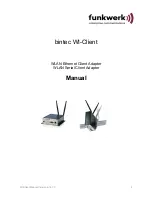
Advanced page
The advanced page offers more detailed options to define the behavior of the WI-Client in the WLAN
environment.
Cloning
The cloning parameter defines the MAC address of the WI-Client’s radio. Usually the WI-Client leaves the
MAC address at the manufacturers value. All devices connected to the WLAN over the WI-Client’s ethernet
port use this MAC address for communication.
The WI-Client keeps a table where the original MAC address of the connected device is linked to its IP
address.
If a data package arrives at the WI-Client on the ethernet port, the WI-Client first checks if there is an entry in
its table with the source MAC address of this device. If the answer is no, this MAC address is added to the
table.
Next it checks if there is an entry for the target MAC address.
If the answer is yes it means that the receiver of this data packet is located on the wired side of the WI-Client
and therefore there is no need to send it over the wireless radio.
If the answer is no, the source MAC address is replaced by the radio’s MAC address and the data package
is sent over the radio to the WLAN
If the WI-Client receives a data package from the WLAN, it first extracts the target IP address. Next it looks
up the corresponding MAC address in its table. This MAC address is placed in the data package which is
then sent over the ethernet port to the connected devices.
With this method several devices can be connected to the WI-Client.
This procedure only works in LAN’s / WLAN’s that use the IP protocol. If other protocols are used, the WI-
Client can be forced to transfer the MAC address of the first data packet that arrives on the ethernet port to
the radio. This method is called cloning. It ensures that all data packages intended for the connected device
are received by the WI-Client. The WI-Client can forward the data to the ethernet port without any further
processing.
This method allows only one device to be connected to the WI-Client ethernet port. This strategy is activated
by selection the option “Eth. Client (var)”.
With the option “Eth. Client (fixed)” the user can defined a MAC address that the WI-Client will use for the
WLAN Connection.
Advanced bridging
Check this box to disable the data exchange between WI-Client and WLAN. Some WLAN-Systems don't
accept that 2 different IP addresses are working with the same MAC-Address. If you check this box, only the
IP-Address of the Client that is connected to the LAN-Port will appear on the WLAN side. The configuration
of the WI-Client over WLAN is still possible with this setting.
Illustration 10: Configuration example
WI-Client Manual Version 2.16 V3
13





















